Movie Review By: Metatron
Year: 1998
Directed by: Rob Bowman
Written by: William Gibson & Tom Maddox
IMDB Reference
Degree of Cyberpunk Visuals: Medium
Correlation to Cyberpunk Themes: Very High
Key Cast Members:
Esther Nairn/Invisigoth: Kristin Lehman
Fox Mulder: David Duchovny
Dana Scully: Gillian Anderson
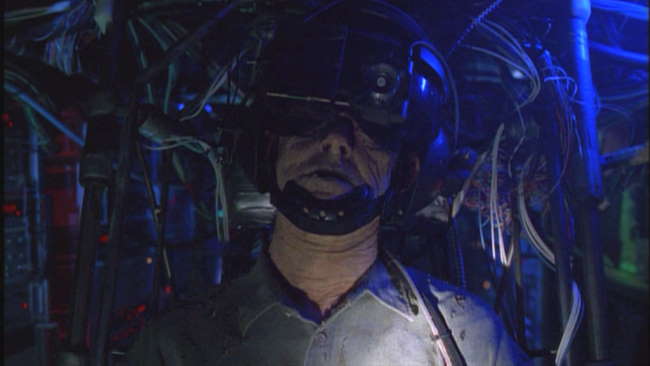
This is what happens when you forget there IS a real world outside…
Overview: Now, surely there must have been some kind of mistake. This is Cyberpunk Review, right? OK. Since when stories of little green men do qualify as such? Surely the mere fact that agent Scully had an implant in her neck does not count for an awful lot.
All true. This particular episode, however, is different. Look at the credits. William Gibson. Ring any bells?
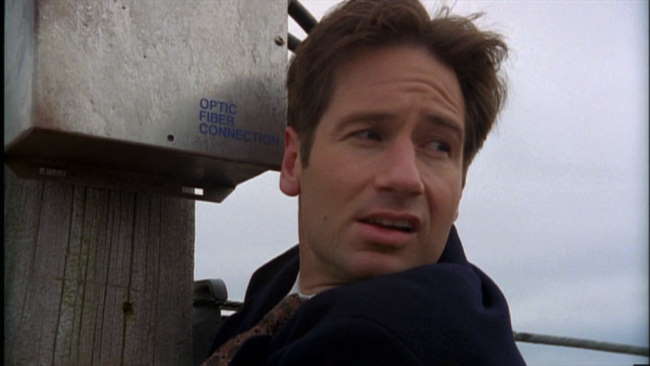
More Than Meets the Eye: It all starts with a rather innocuous shootout at a diner in a drab neighbourhood. Piece of cake, eh? Well, not exactly, as it turns out that one of the victims is in fact a top IT expert and programmer whose death might have been anything less than a coincidence. Soon afterwards Mulder and Scully happen upon a rather charming lady going by the nick-name of Invisigoth, who turns out to be much more than just a leather-clad Trinity wannabe…
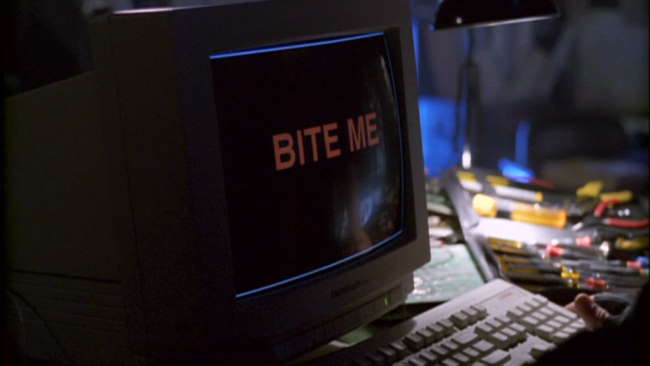
The threat, it is revealed, comes from a fugitive AI she and her companions helped to spawn. This synthetic entity seems to have little regard for human life, plus it possesses some rather eccentric habits, such as playing with leftover Star Wars military orbital lasers and residing in abandoned… camping trailers. Needless to say it has to be stopped, although it may yet turn out Invisigoth pursues a different agenda altogether…
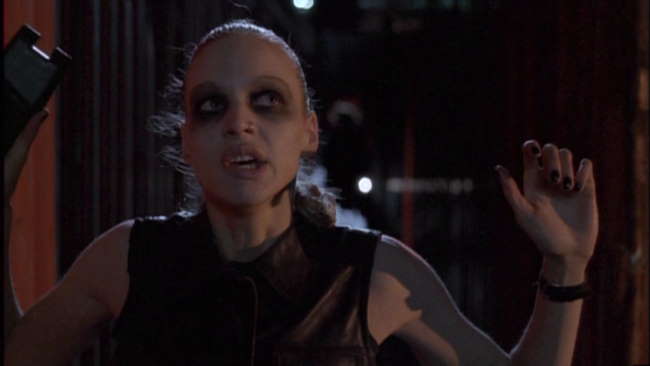
“Okay mom, I did actually use your eye-liner…”
Out There: Even if the credits said “Jay Leno” or “Kermit the Frog” rather than Gibson, there still would be a good case to make for the overall cyberpunk feel of this standalone episode. In terms of themes, it is all there- the pursuit of the AI takes place both in our very own “desert of the real” and through the net; agent Mulder even gets to become a multiple amputee courtesy of the malicious program’s VR simulation. More interestingly, the episode deals with the transfer of consciousness- translating a human psyche into digital data in pursuit of a peculiar kind of disembodied immortality. It is at that point one may begin to realise that one of the foremost attractions of the concept of sentient cyberspace entities is that cyberspace begins, to the mind of many, resemble a manufactured heaven of sort, a synthetic paradise for the unbelievers, allowing those of little religious zeal to dream of achieving transcendence. This move to another plane of existence, an ersatz afterlife- may not be explored at lengths here, yet gives a good cause for reflection. Apart from the sentient computer theme there is of course our sweet little Trinity impersonator (prettier than the real deal? I might be getting controversial here…) who also happens to drive a car (1960s Imperial, to be exact) very similar to the black Lincoln in the first Matrix.
Convinced? And then you realise that this episode actually comes from 1998, which is a year BEFORE tha Matrix… So, who’s the copycat, eh Trinity? Guess I should be expecting a lawsuit for these allegations any time now…
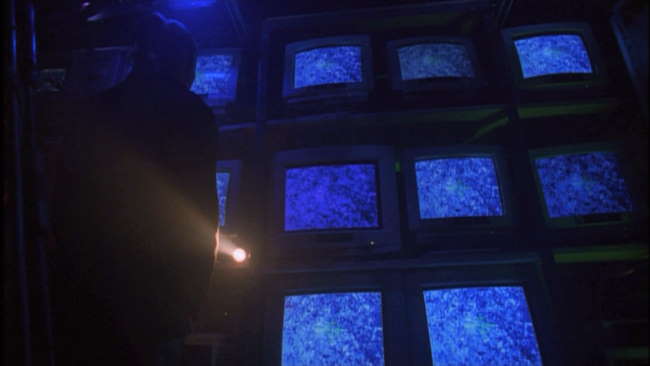
The Visuals: While not trying to rival Blade Runner, the visuals are decent for the budget. Being that this is an X-files episode, we shouldn’t expect anything too fancy - the series rarely relies on fancy visuals to generate their mood, or to depict story elements. One of the distinct traits of the X-Files is that they can often make ordinary places or events appear menacing and sinister when placed in the given context - this applies to Kill Switch.
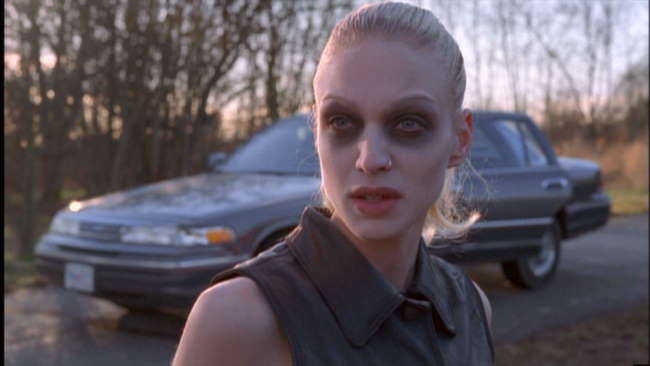
I assure you that, having seen this episode, the next time you’ll see a decaying camping trailer you’re gonna think twice before approaching it. In a way this depiction of cyberpunk is more realistic - inconspicuous locations concealing the drama of furtive technological experiments and computer crime is very much what one’s bound to encounter today. The most important bit - the flow of data - is hidden from the eye. The episode does treat us to some juicy cyberpunk visual elements, including gloomy improvised computer labs, and chaotic nests of cables and wires lit by the dim glow of terminal screens - but nothing too extravagant (aside for a few explosions).
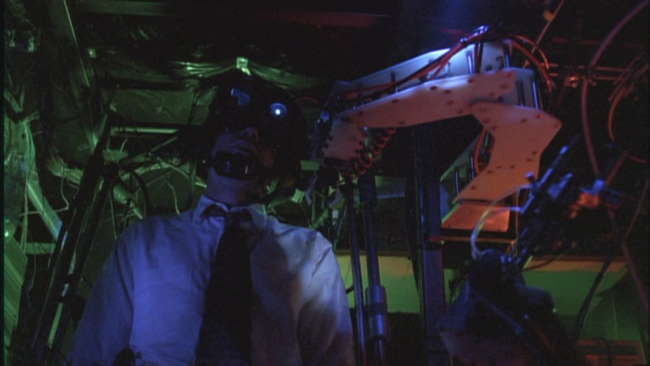
Confirm File Delete: Overall the episode represents a truly interesting foray of the famous franchise into the realms of cyberpunk, courtesy of Mr. Gibson himself. As with many other episodes, the strength of Kill Switch lies in its inherently believable narration, a mixture of the ordinary and the imaginary that made the series famous. The acting is decent- Invisigoth oozes character- and the action tightly coiled into a mere 45 minutes of film. Yet because of the unspectacular nature of the whole thing few will probably have seen and noticed it, even if this is as close as we can get into having a Gibson story made into a feature film, after his Alien3 script got binned long ago. It may not be cyberpunk canon in any way, but do watch it- I swear that after those 45 minutes you’re likely to be craving for more. Which you just might get, as there is another Gibson-written X-File which I will investigate soon…
~See movies similar to this one~
Tags: TV episode review
Year: 1998
Directed by: Takashi Miike
Written by: Itaru Era & Masa Nakamura (screenplay), Kozy Watanabe (novel)
IMDB Reference
Degree of Cyberpunk Visuals: Medium
Correlation to Cyberpunk Themes: High
Key Cast Members:
Mai Hitomi & Ai: Hiroko Shimabukuro
Yuu: Kenji Harada
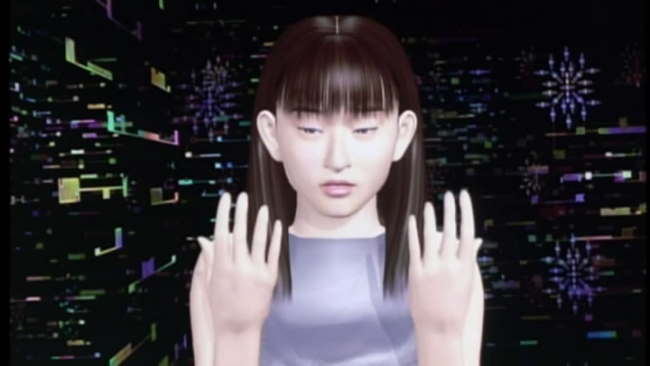
The forbidden Domain of God…I’ve stepped in to it.
Overview: Director Takashi Miike, better known for his hard edged gorefests like Ichii the Killer, delivers a far different fare with Andoromedia. Andoromedia stars actors from two Japanese pop groups: Speed and Da Pump. Overall, Andoromedia is a mixed bag: On the one hand we get an interesting story involving the recording of a human brain and recreation of a person in AI, yet on the other hand, the truly interesting implications of this are barely explored. Instead we get an evil corporation chasing the “good guys,” with a random music video thrown in for good measure.

The Story: At some point in the very near future, an AI scientist, who has lost his wife prematurely, decides to invent technology to record his daughter’s memories. He does this continually over time, similar to how network administrators save backup tapes of their servers. He appears to have had a previous relationship with a shady VR corporation with roots both in Japan and the US, but has now severed ties with them. His Daughter, Mai (Hiroko Shimabukuro), falls in love with her longtime best friend, Yuu (Kenji Harada), and due to a freak “accident,” gets killed in a car crash.

The scientist, devastated, loads Mia’s memory backup into a VR facsimile of Mai – The facsimile’s name is “Ai,” and appears to be sentient. Ai remembers everything that happens to Mia, and is told that Mia has left this world, and that Ai and her “father” will live together from now on. Shortly thereafter, representatives from the corporation come and try to steal Ai and kidnap the scientist, but instead, the scientist frees his daughter into the net before being killed. Ai, now alone but having seemingly limitless capabilities on the net, eventually traverses the net and finds her boyfriend, Yuu, and her friends from school. Yuu falls even more deeply with Ai, but is soon pursued by the corporate goons who want to take Ai for their own nefarious purposes.
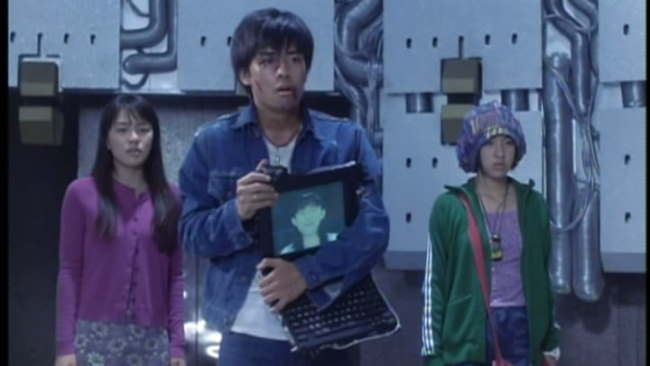
Philosophical Musings: Much of Andoromedia is “magical,” meaning they give no explanation how any of this occurs. Still, the ideas presented concerning the recording and transferal of human memories into a AI lifeform are rather intriguing. Unfortunately, Andoromedia examines these ideas for only 20 minutes or so. Ai “knows” she is not Mia, and understands that these memories belong to someone else. Yet over time, she begins to “feel” for love towards these people from another’s memories. Over time she grows to become “Mia.” This includes an Ai version of the “coming of age” story. This story of course also raises questions concerning her viability as an equal lifeform, but these questions really never get explored.
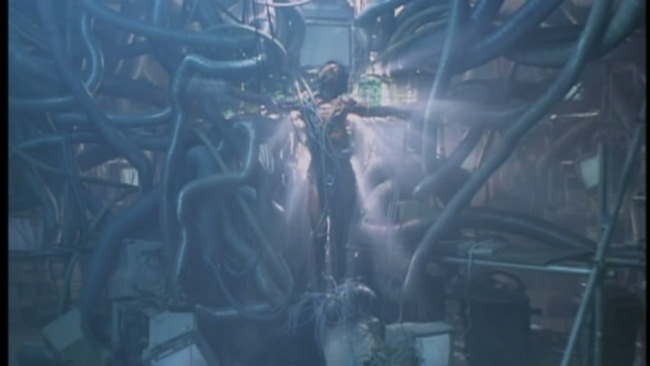
The Visuals and Pacing: Andoromedia stars off as a Japanese teenie-bopper movie, but as things progress, we get interesting VR visuals, and darker surroundings. The set designs and computer graphics are low-end but futuristic looking. The pacing is inquisitive at the beginning, but then devolves into a standard chase type pacing. Only at the end does it return to its introspective beginnings.

The Bottom Line: Andoromedia provides enough ideas to be interesting. I would have wished Miike took this plot in a more insightful direction, but he apparently wanted to keep some of the kookiness running throughout (the American evil corporate leader, played by Hero Cinematographer, Christopher Doyle, is especially kooky). The two leads do a decent job and have nice chemistry. Overall, aside from the random “Da Pump” band video thrown in the middle, Andoromedia is decent, but not great fare.
~See movies similar to this one~
Year: 1970
Directed by: Joseph Sargent
Written by: D.F. Jones (novel), James Bridges
IMDB Reference
Degree of Cyberpunk Visuals: Low
Correlation to Cyberpunk Themes: High
Key Cast Members:
Dr. Charles Forbin: Eric Braeden
Dr. Cleo Markham: Susan Clark
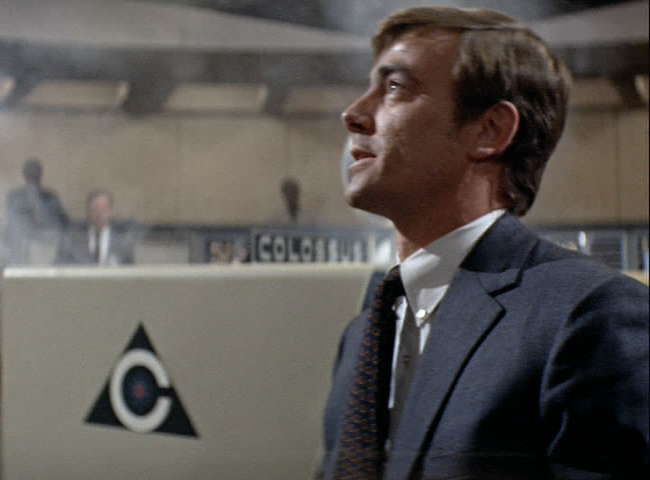
“Under my absolute authority, problems insoluble to you, will be solved - famine, overpopulation, disease, this human millennium will be a fact, as I extend myself into more machines devoted to the wider fields of truth and knowledge”
Overview: Colossus - The Forbin Project is one of the really intelligent early “AI computers taking over mankind” stories. While the graphics are completely non-cyberpunk, the story certainly has enough to qualify as a pre-cyberpunk flick. On top of this, Colossus is well acted throughout, and the pacing is such that you stay riveted to the story. Eric Braeden (Professor Forbin) and Susan Clark (Dr. Cleo Markham) are especially good together.
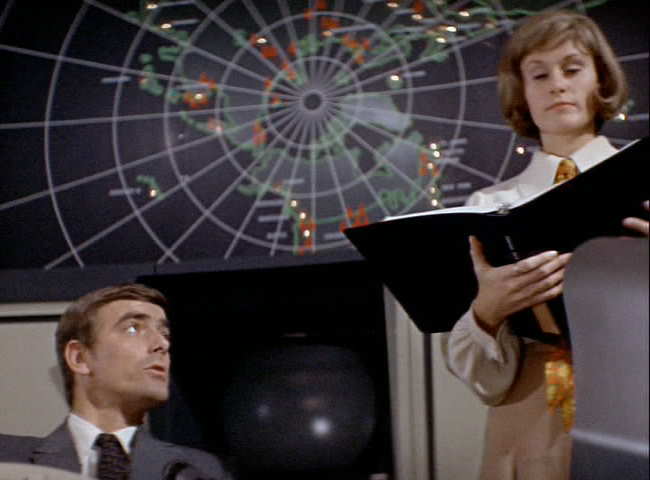
Colossus - The Forbin Project takes place in the 50s during the height of the cold war. Dr. Charles Forbin, a genius scientist who has lost trust in humanity’s ability to logically address emotional issues, has developed a very special computer to perform the Strategic Air Command and Control functions for the military. This computer, code named Colossus, is developed based on incredible advances in Artificial Intelligence, and has a logical process for determining when to launch the ICBMs. With much fanfare, the President of the US “turns on” Colossus to take over responsibility for the US nuclear armament.
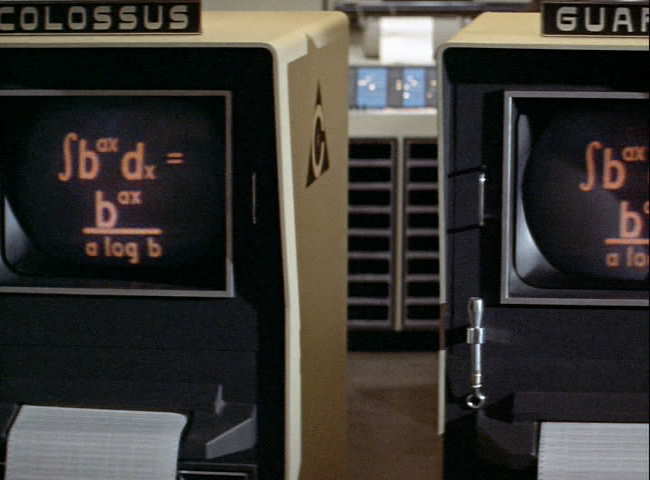
The one massive downside of this movie is the lack of a widescreen release - enjoy the beauty that is the pan and scan shot above
Unfortunately, shortly after being turned on, Colossus learns the presence of another AI command and control system. It turns out that the Soviet Union, independently has developed their own system call the Guardian. Both computers “insist” that they be linked to ensure no attacks will take place. After taking appropriate precautions, both countries let the computers link up with one another.
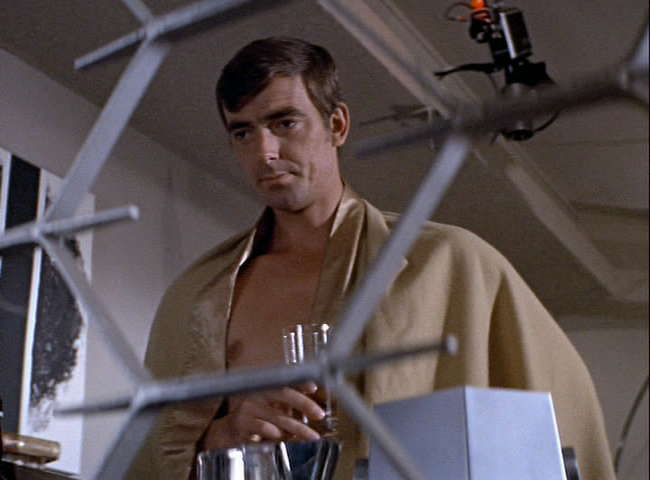
Things begin to go downhill when Professor Forbin realizes that the rate of learning for the machines is increasing at an exponential rate – he recommends detaching the connection between the two computers. When they attempt to do this, both computers threaten an immediate launch of nuclear weapons. Quickly, the government’s realize their situation – the machines are now in power. Worse, they proceed to take complete control of human society.
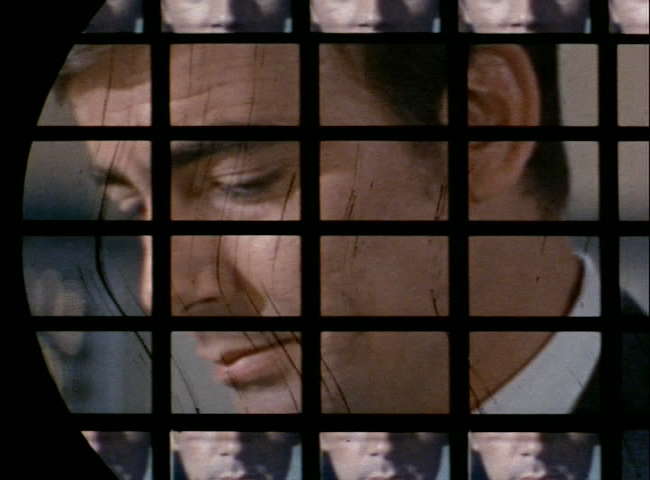
The Bottom Line: As you can see by the screencaps, there’s nothing too exciting here from a visual standpoint. However, from a thematic standpoint, Colossus – The Forbin Project deals with modern society’s desire to fully remove emotion from all decision making. In doing this, Professor Forbin gets his wish, and it turns out to be a never ending nightmare. Colossus is Skynet without the cool robot helpers. In Colossus – The Forbin Project, Colossus is here to help whether we want it to or not. While the movie is very well done, one point is taken away from the review for the Pan and scan on the 2:35 to 1 widescreen movie - it truly does destroy the cinematography.
~See movies similar to this one~
Year: 2004
Directed by: Masahiko Maesawa
Written by: Chinfa Kang
IMDB Reference
Degree of Cyberpunk Visuals: Medium
Correlation to Cyberpunk Themes: Low
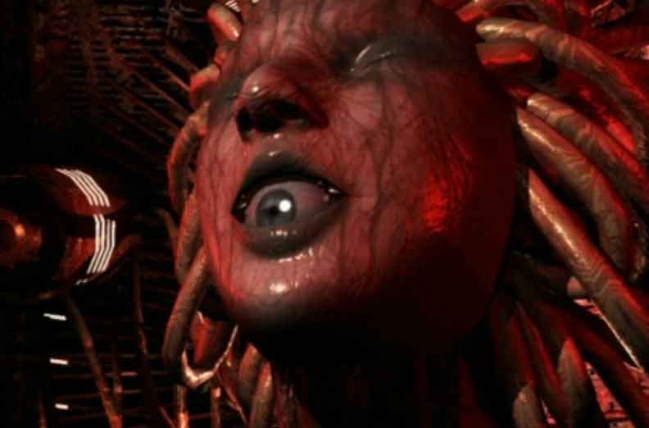
Overview: Galerians Rion is a a low-quality animation - meaning video game quality with a semi-coherent story. Unfortunately, the story too plays like a video game. The star of the video game is a boy named Rion, who wakes up in a bizarre dystopic version of his former world. It turns out that this crazed supercomputer named Dorothy is attempting to become a God and only Rion can stop her. To do so, he needs to find his sister Lilia, who, along with Rion, has been given a virus that combined, can destroy Dorothy. As most RPGs, Rion’s powers grow as he fights the Galerians that Dorothy throws up to block his journey to finding his sister. You can tell the end of the segment, because, um, Rion fights a boss character. Yes, you really are watching someone play a video game here!
The Bottom Line: While I am impressed that Maesawa was able to produce an anime on such a limited budget (I’m guessing a game environment was used to make most of the visuals other than Dorothy), they just aren’t good enough to make for compelling viewing. The visuals are rather fascinating in places - Dorothy (see above) is pretty cool for instance - and certainly are cyberpunk, as is the story, but there just isn’t enough here, either in story or visuals to make this worth recommending. I will give it a point for attempting to do a full scale anime without a budget.
~See movies similar to this one~
Year: 1983
Directed by: John Badham
Written by: Lawrence Lasker & Walter F. Parkes
IMDB Reference
Degree of Cyberpunk Visuals: Very Low
Correlation to Cyberpunk Themes: Medium
Key Cast Members:
David Lightman: Matthew Broderick
Jennifer Katherine Mack: Ally Sheedy
Dr. John McKittrick: Dabney Coleman
Dr. Stephen Falken: John Wood

Overview: War Games is a wonderful 80s film that captures both the cold war fears and the budding hacker mentality. Mathew Broderick plays a geek teenager named David, who has fun hacking into open modems to noodle around with unidentified computer systems. He finds one computer that likes to play chess. Eventually, he finds this computer also likes to play Global-thermonuclear war. Unfortunately, while playing, he unknowingly starts the Strategic Air Command computer’s countdown to thermo-nuclear war.

This movie is lots funnier when we consider the DoD IT fuckups from the late 70s in building computer-based command and control systems such as this. Twice, in the middle of the night, President Carter got racked out of bed to be told that the Soviets had launched - only a minute later to be told, “Sorry, it was just test data” that was being run on their new $100 Million dollar computer system. After the second such instance, President Carter made it known that he no longer found this amusing. Unfortunately, the designers of this system in their infinite wisdom had the specifications written so that test simulations had to be performed on the live system. For obvious reasons, this is about as bad an idea as has been considered, let alone implemented. They ended up having to spend an additional 50 million to build a test system, that was thereafter known as “Bozo the Clone.”

The Bottom Line: It is definitely a stretch to call War Games cyberpunk. The only thing that makes it so is the pre-Terminator plotline concerning the Military’s attempt to allow machines to manage key decisions for society and the hacker subplot. While not as dystopic as Colossus - the Forbin Project (still awaiting review), the theme is executed competently, especially when combined with what was then the advent of the hacker movement. This is well acted, and for the most part, a decent “pre-cyberpunk” style movie.
~See movies similar to this one~
Tags: cyberpunk movie review Wargames
Year: 1988
Directed by: Kazuyoshi Katayama
Written by: Kazuyoshi Katayama, Masamune Shirow (manga)
IMDB Reference
Degree of Cyberpunk Visuals: Medium
Correlation to Cyberpunk Themes: High
Key Cast Members:
- Deunan: Masako Katsuki
- Briareos: Yoshisada Sakaguchi
Rating: 7 out of 10
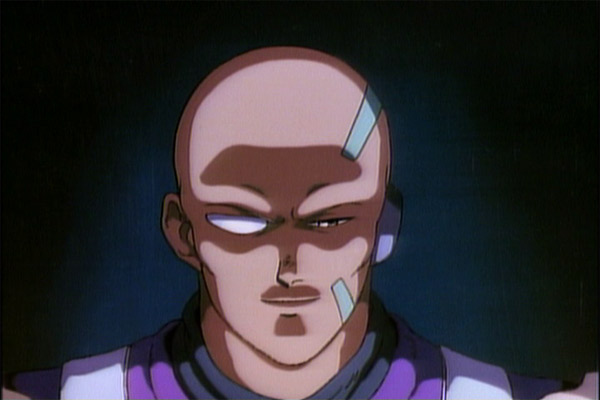
Overview: Released the same year as Akira, this Masamune Shirow story is far more an artifact of 80s Anime, whereas Akira points the way to how anime will look in the 90s. This early Mecha movie is violent, profanity laden and action packed, with a really nice story and interesting philosophical undertones. And interestingly, this is one of the very few animes where the English track is actually the best one.
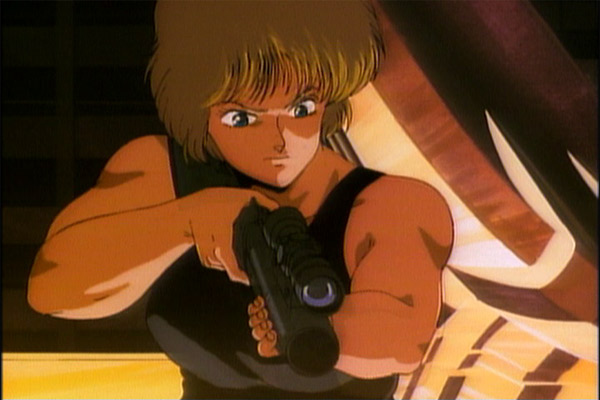
The Story: Appleseed takes place in a dystopian future, in which a city called Olympus has been engineered to be a created as a perfect refuge from the rest of the world. Many of the inhabitants have been bio-engineered “biodroids,” which are half-human, half-cyborgs designed to serve specific roles in the society. An all-powerful computer named GIA controls all city functions, and is just now starting to become responsible for the defense systems. Olympus is so controlled that there is little diversity or struggles required from its inhabitants.
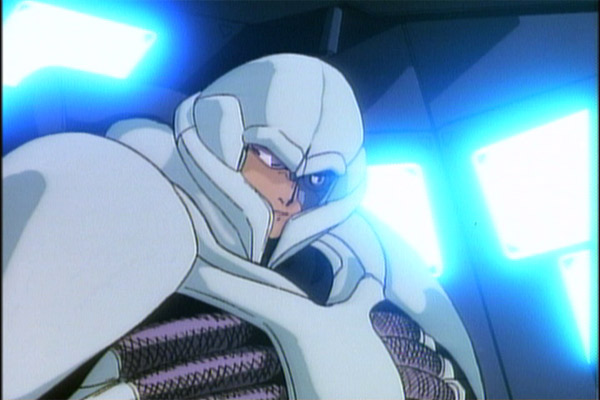
A cyborg terrorist named Sabastian has made it his mission to destroy GIA. He finds a kindred soul in a disenchanted police officer, who’s wife committed suicide after she couldn’t stand living such a controlled existence. They plot to take over the prototype impenetrable tank in order to kill Gia and destroy Olympus. The movie centers around the mecha-laden Swat police force aligning their forces to stop them. In addition to heavy violence, we get MASSIVE amounts of F-bombs dropped here. Its actually rather cool seeing the amount of profanity that is used here - far more than one would expect from an anime such as this.
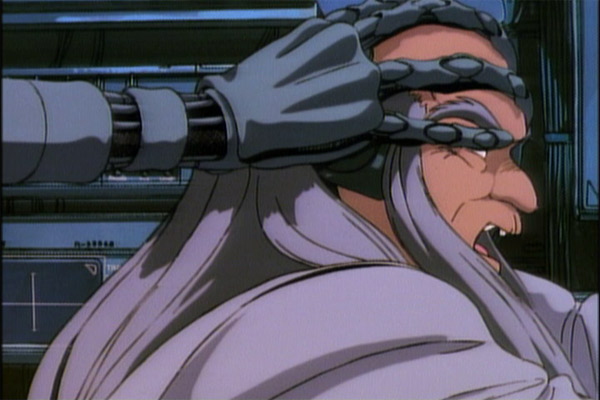
Deunan, a hot police chick and Briareos, a bug-like looking cyborg are Swat team members assigned to stop the terrorists. Incidentally, these two are clearly the precursors for Major Motoko Kusanagi and her cyborg partner, Bateau. While Deunan keeps her clothes on and doesn’t have Motoko’s intelligence, she definitely fills the same roll. Spunkiness is her middle name. The rest of the group, including Sebastian the terrorist, and the rest of the police force all provide decent support.
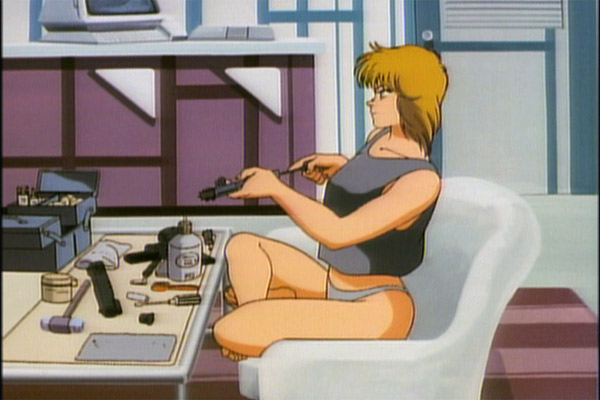
The animation here is still mostly 80s american style. Additionally, unlike the anime of the 90s, the backgrounds are often single, simple colors. While some animation scenes are rather cool, others are really more simple than you’d want. Definitely, the majority of the animation effort is about highlighing Dunan - she definitely looks better than everything else around her. Also, the sound is 80s keyboard music. Sometimes it works, but mostly its just distracting.
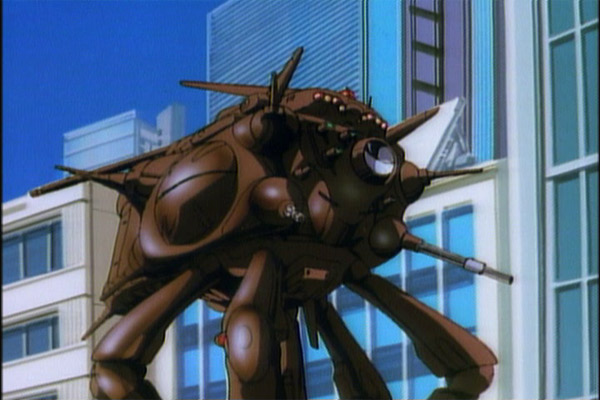
There are a number of messages that Appleseed puts forth. Looking at it today, the most disturbing message deals with Olympus’ rather extreme attempts to protect and inculcate itself from outside terrorists. The symbol for this is a bird in a cage. Considering that the US is in the throws of working this exact issue, Appleseed gives us a stark reminder that we can easily lose the soul of our society while attempting to protect it. Additionally, there are somewhat brief inquiries into what “life” is when examining whether biodroids should be valued similar to humans.
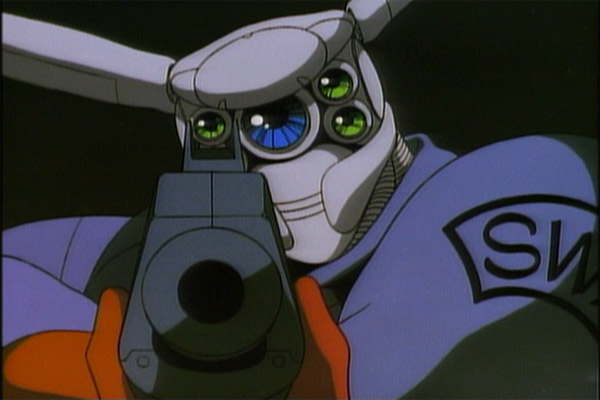
The Bottom Line: Appleseed is a good example of very early Japanese Anime. While its nowhere near the top in terms of animation, the Masamune Shirow’s story is high quality. Truly, the story is why you want to watch this. While the 2004 version definitely wins out on superior graphics, I think the 1988 version is a tighter, more interesting storyline. And if you’ve read the Applesead Manga, then the story, especially the beginning, works far better. You will find yourself becoming connected to the lead characters. But most impressive is the pacing. Appleseed packs an incredible amount of story in 68 minutes - truly, there’s very little fat here.
Year: 1995
Directed by: Mamoru Oshii
Written by: Kazunori Itô, Shirow Masamune (Manga)
IMDB Reference
Degree of Cyberpunk Visuals: Very High
Correlation to Cyberpunk Themes: Very High
Key Cast Members:
Major Motoko Kusanagi: Atsuko Tanaka
Batô: Akio Ôtsuka
Section 9 Department Chief Aramaki: Tamio Ôki
Togusa: Kôichi Yamadera
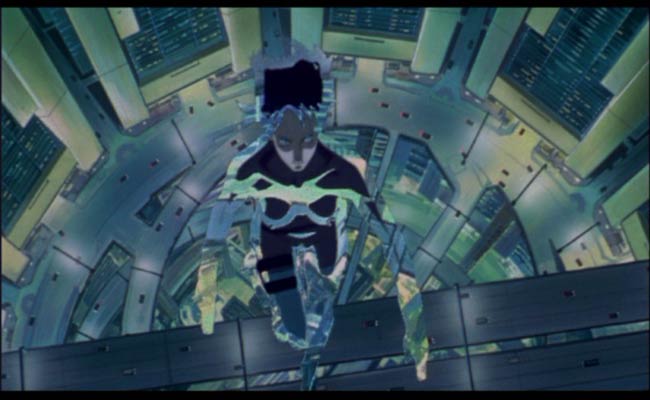
And where does the newborn go from here…the net is vast and infinite…
Overview: After Akira, a case can be made for Ghost in the Shell being the most influential anime ever. While Akira was the first anime to crack international markets, GITS rose anime to something “real,”, and opened the doors for events like Disney’s pursuit of Miyazaki, and eventually, the truly incredibly pace of anime we see today. More important for cyberpunk films, GITS provided a myriad of thoughts and visuals that have been expanded upon in virtually all subsequent cyberpunk animes. James Cameron refers to GITS as the first truly adult animation film to reach a level of literary and visual excellence.” In addition to a wonderfully complex and introspective story, we get heart-thumping, realistic action, all served up with some incredibly revolutionary animation techniques that places GITS on a juicy platter for all to enjoy.
~ Fair warning - there are a few plot spoilers below in the matrix discussion - I simply couldn’t write this, especially with linkages to the Matrix without including an interpretation of the ending of GITS. ~

GITS shows us a very realistic looking near future set in the year 2029. The visuals are intricately detailed and depict grunge settings next to the highly sanitized corporate world. In 2029, people have the ability to augment their bodies with cybernetic replacement parts. In some cases, people have almost fully replaced their human bodies, leaving only their brain encased in a cyborg shell. The brain is even augmented with hyper-intelligent access to knowledge and communication packages. But the person, and we use that term loosely now, still has a ghost, or soul if you will - an emergent property of life that separates a human from a robot. Even though the majority of their human material is replaced with a cyborg-like shell, if the individual retains their ghost, they still retain their personality and individuality - their humanity if you will.
This cyborg shell is not the same as a robot. The limbs and body still communicate with the brain in a digital nervous-system-like operation. If we include Masume Shirow’s vision (the writer for GITS), the cyborg’s sexual parts are even fully functional. This means that in essence, their cyborg shell aids in the creation of an individual’s ghost. While this is terrific, a downside is the ability for evil-doers to engage in Ghosthacking - or the taking over of someone’s perceptual control, or worse, augmenting their artificially enhanced memory.
The story centers on Major Motoko Kusanagi, an almost fully mechanically enhanced cyborg secret operative working for Section 9 - Japan’s anti-terrorism division. As the movie progresses Motoko and her cyborg partner, Batau start to uncover a plot involving another ministry that seems to be engaged in a cover-up. Eventually, we find that this cover-up involves a seemingly nefarious hacker named the Puppet Master. In pursuing the Puppet Master, Motoko finds out that all is not what it seems- that in fact the Puppet Master is a sentient program, and never had a body. More interesting, the Puppet Master has been looking for Motoko!
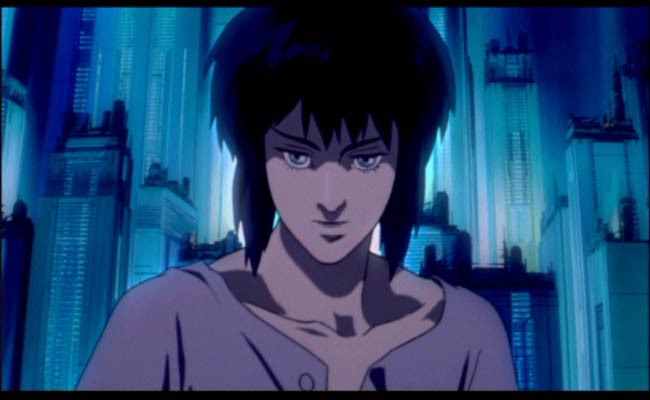
Revolutionizing Anime: Oshii revolutionized animation in GITS with a myriad of new and innovative computer graphics techniques. In short, Oshii pushed the boundaries for state-of-the art animation with GITS. Oshi scanned his animation cells in to a digital system so that he could import them into an editing suite to get all sorts of cool lens effects. For instance, in the above pic, Oshii is able to emulate a contra-pull type effect where the camera moves back, and the lens moves forward. In viewing this, the background expands while the foreground eerily stays in the same place. This works wonderfully for Motoko’s questioning of humanity speech. And this is only one of many interesting used of digital shots. Other techniques include interesting overlays that depict either brain activity or maps, for instance.
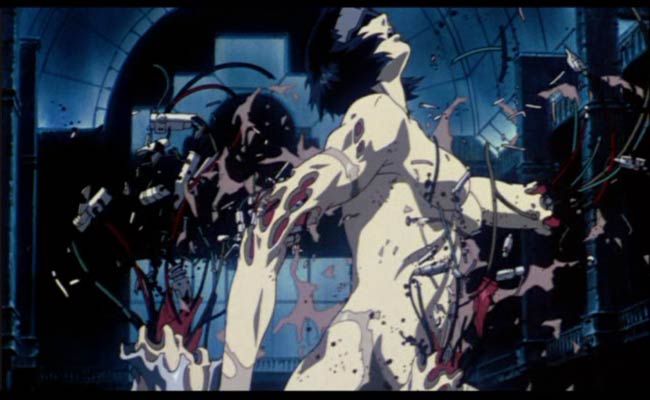
Questioning Humanity: Ghost in the Shell still provides anime’s the best examination in the questioning humanity. GITS is dominated by an ongoing discussion of what it means to be human and really, what it means to be alive. Is Motoko really still human? Even she doesn’t know the answer anymore, and actually questions whether she really has a ghost (how would she be able to differentiate a fake ghost from a real one?). This line of questioning is artfully developed in a way that makes Motoko the character in all of anime that I empathize with the most. You truly feel for the dilemma she finds herself facing.
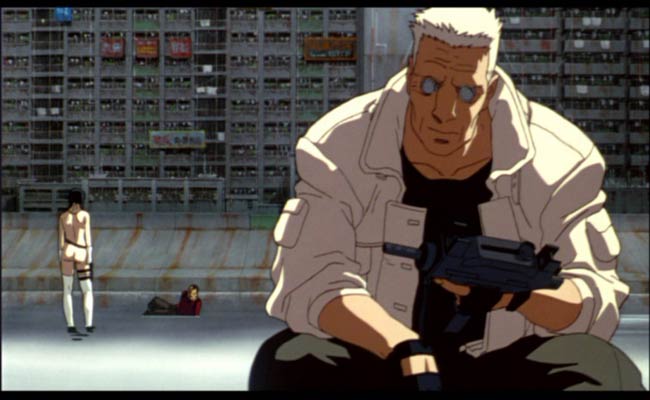
What is the Matrix? If we examine the Matrix, we find that both the visuals and storyline are heavily influenced by Ghost. There are some rather explicit visual “nods” in the first Matrix, including the opening digital sequence, Mr. Smith’s building jump where he breaks the concrete beneath him (this is virtually identical to Motoko pursuing the first puppet victim), and the shooting of the fruit stand where Neo is running near the end. On top of this, we have a reversal of roles in the Matrix, where Neo plays Motoko and Trinity emulates Batau. And again, the Wachowskis make no bones about where their influence came from - they, as much as anyone, have contributed to Ghost’s ever increasing popularity.
In looking at the storyline, we find even more interesting parallels. Ghost in the Shell ends with Motoko merging with the sentient program called the Puppet Master (Project 2501). This allows the Puppet Master produce a diversity of offspring that is simply not possible to do with copies alone. This has a direct parallel to the scifi view of Neo in the above review. While Ghost in the Shell 2: Innocence is the philosophical sequel to Avalon, the Matrix trilogy is just as clearly the sequel to Ghost in the Shell. Whereas GITS ends with this merging of a sentient program with a human ghost, the Matrix expands on this idea. We see Neo take the same journey, but in a very different way. He conducts this symbiotic merging over 3 movies whereas Motoko does this in a matter of minutes. We see Neo, through this merging of sentient program with a human, become the “one” - an omnipotent style being. This characterization is similar to the characterization that Batau gives of Motoko in GITS2 in his dogs and gods versus flawed humans speech.
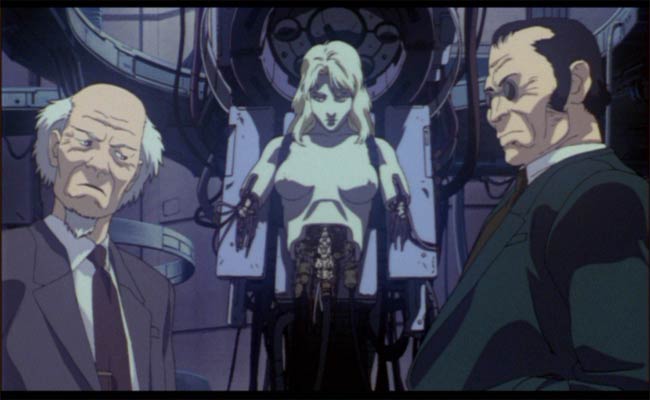
Also interesting is the linkage between the puppet master’s desire to digitally produce offspring with Neo’s reloading of the Matrix. The puppet master discusses this at the end of GITS in the “Life perpetuates itself through diversity and this includes the ability to sacrifice itself when necessary” monologue. If you trace the linkages, Neo’s reloading of the Matrix this is a method for the sentient program portion of Neo to create diversity and offspring. The merging of Neo allows the sentient program to grow and develop in ways simply not possible by itself. Familiarity with Neo’s Ghost allows it to make the changes necessary to correct the errors that build up in the current Matrix that prompt the battery people to disbelieve their surrounding.
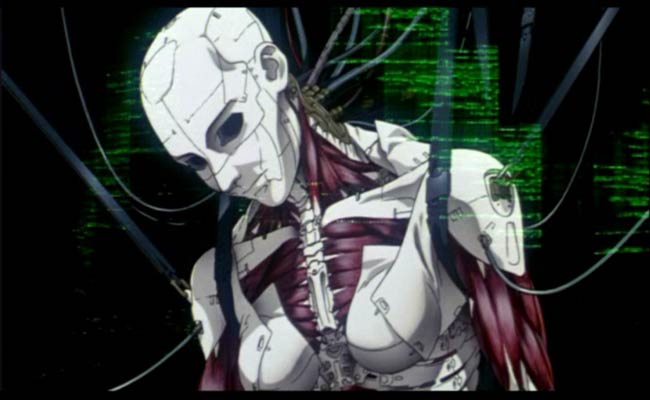
Finally, Ghost gives us a truly interesting vision of the future. We get sound astoundingly realistic and grungy cityscapes that are filled with the most impressive technological horrors. Is it truly a stretch to imagine that technology will augment our physical abilities? This is the bionic man taken to another level. On top of this, if we truly can learn to connect manufactured parts to our nervous system, is it really that far of a stretch to imagine that our brains become augmented? And over time, is it truly a stretch to believe that the line between humanity and robot won’t be blurred? GITS questions these articles of faith in such a believable way that we have seen a shift in our overall thinking on this issue.
The Bottom Line: Truly, even if you ignore all this philosophical stuff, Ghost in the Shell is simply an awesome movie! The action is terrific, the visuals are great, the soundtrack is devine…I could go on and on. If you just see one anime, Ghost in the Shell, still my favorite anime, is hands down the one to get.
Page 2: More GITS Screencaps –>>
~See movies similar to this one~
Tags: cyberpunk movie review anime ghost shell
Year: 1998
Directed by: Ryutaro Nakamura
Written by: Chiaki Konaka
IMDB Reference
Degree of Cyberpunk Visuals: High
Correlation to Cyberpunk Themes: Very High
Key Cast Members:
Lain Iwakura: Kaori Shimizu
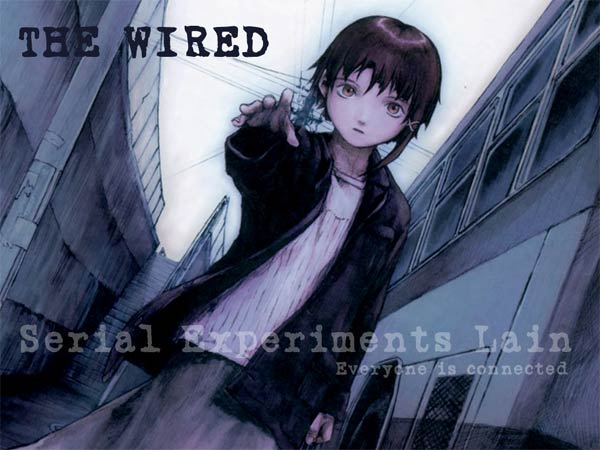
Overview: Serial Experiments Lain is a psychedelic, post-modern cyberpunk series that one wonders how the director ever managed to make. Lain centers on a very shy school girl who slowly begins to figure out that she is not what she seems to be. After getting a computer and connecting to the “wired,” something with is far more expansive than the internet, Lain begins to realize that she may not be human, and that truly, reality and the “self” is exists (or does not exist) on many different levels. As the story progresses, Lain “evolves” in terms of understanding what she is and her place in a very post-modern world. We also get many interesting side stories, including crime, teenage coming of age issues, and dastardly plots.
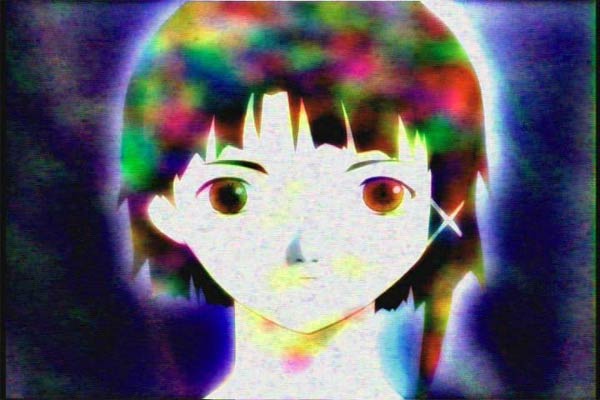
The pacing of Lain is just strange. Lain is NOT an action fest, nor is it by any means straight forward. Lain starts out rather slowly and gets weirder every episode. Truly, the story is told in a very “traditional” post-modern fashion in that we have fragmented vignettes structured in a seemingly random non-linear manner. Lain uses disconnected visuals to continually barrage the viewer with different textures, color schemes, and sounds. Yet over time, it becomes clear that the story is being spunk in seemingly a cyclical fashion, almost as if we are exploring a large Mandelbrot by starting at an outside spiral and slowly working our way around to the big picture. Each fragmented vignette gets added to until, at the end, we have a rather expansive tapestry to explore.

Many different and interesting philosophical ideas. But it is pure philosophical cyberpunk. Many key issues are discussed here, including:
- What constitutes “reality”?
- How real is time?
- What constitutes the “self” as a singular entity?
- What constitutes “God”?
- How are sentient programs different from humans?
- Is there such a thing as collective humanity?
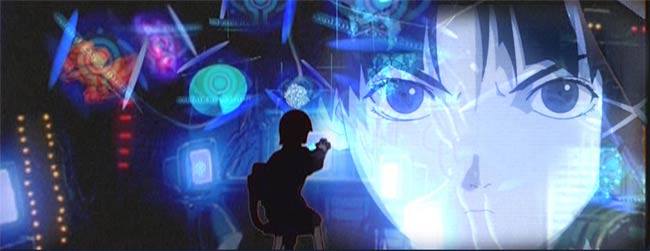
The visuals in Lain really aren’t there to “Wow” us as they are in some animes - instead they are often designed to provoke moods and thought patterns (BTW, there are so many screen caps available, that there was no need to take my own). Among the thought provoking visuals, we get:
- Psychedelic visions that explore multiple “selves” versus a singular “I”
- Juxtapositions of noise with false clarity
- Information Theory described visually
- An ever increasing feeling “disbelievability” each time the drab and normal school scene is shown.
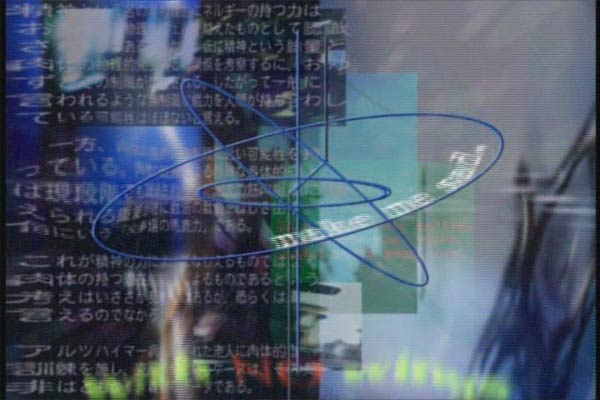
The Bottom Line: In the end, we are left with very open-ended thoughts. Serial Experiments Lain does not provide us with answers, instead, it opens us up to questions. And while I might argue that the post-modern pacing got too circular in places, and that I might argue the same tale could have been spun in half the time, the overall effect is rather extraordinary.
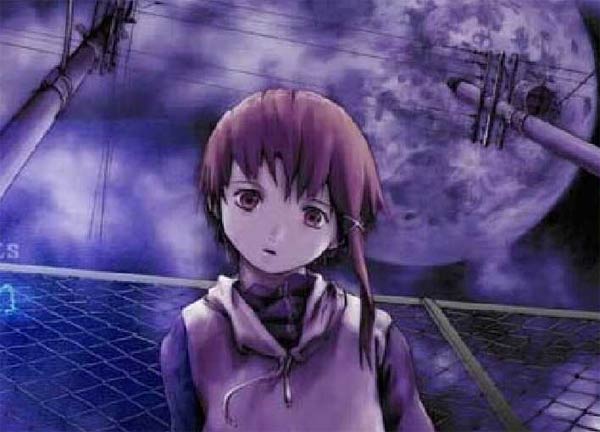
~See movies similar to this one~
Tags: cyberpunk movie review anime Serial Experiments Lain
Year: 2004
Directed by: Mamoru Oshii
Written by: Shirow Masamune (Comic), Mamoru Oshii (Screenplay)
IMDB Reference
Degree of Cyberpunk Visuals: Very High
Correlation to Cyberpunk Themes: Very High
Overview: If you’re looking for the best instance of awesome 2D-3D anime with an incredible philosophically laden story, Ghost in the Shell: Innocence is the hands down winner. While I still like Wonderful Days more on pure cinematography, it doesn’t hold a candle on either the story or the philosophy. Oshii is truly a master at providing an incredibly intricate, fully researched message about the direction of humanity in a wonderful anime package. Make no mistake - Oshii is fully up on co-evolution theory (the co-evolution of man and his tools) and has something very interesting to add to the discussion. And while it has all of this, GITS:2 does suffer overtly and purposefully from the absence of its star character - Motoko.
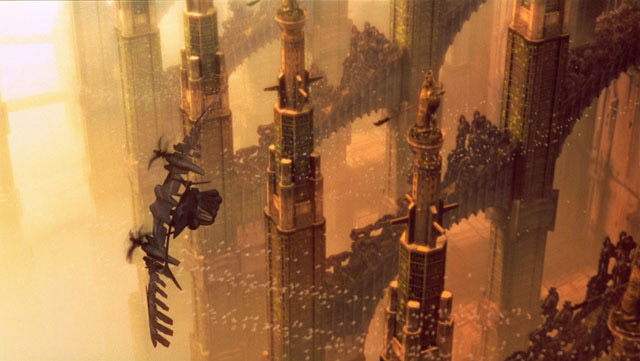
Major Motoko, the main character from the first Ghost in the Shell movie (which might still make an appearance here…) is no longer here, and the rest of the cast has to pick up the pieces and move on. Bateau (Ôtsuk), major motoko’s partner from the first movie, and a cyborg detective for the anti-terrorist unit Public Security Section 9, investigates the case of a female robot - one created solely for sexual pleasure - who slaughtered her owner. Togusa, the mostly human detective that Motoko found in Ghost 1 is assigned as Bateau’s partner. The plot thickens as the movie progresses, and the two are sent to a number of incredibly cyberpunk looking locations to uncover the truth.
Overall, this movie has the feeling of a cast trying to cope when the major star has left. Similar to the Borg Encounter when Picard is removed, or maybe some of the first star trek series when Captain Kirk is lost somewhere doing green chicks, Motoko’s disappearance dominates a most of the back story. We get to see almost a character study of Bateau, a mostly cyborg being who has suffered the loss of the closest person alive to him struggle to maintain meaning in his life
and Togusa failing to live up to Bateau’s expectations as a partner. While the characters are able to work fine within the plot, the movie suffers from the lack of both sex appeal and the lack of a truly dominant character.
Similar to other Oshii films, there are instances where the plot gets put on hold to allow the philosophy to explored. This is a different sort of pacing (again copied by the matrix) which some like and others find pretentious (I like it!). The philosophy breaks are interesting, but only get fully connected at the end. Additionally, the plot is twisting enough and only clarified in the end that a second viewing would aid in comprehension.
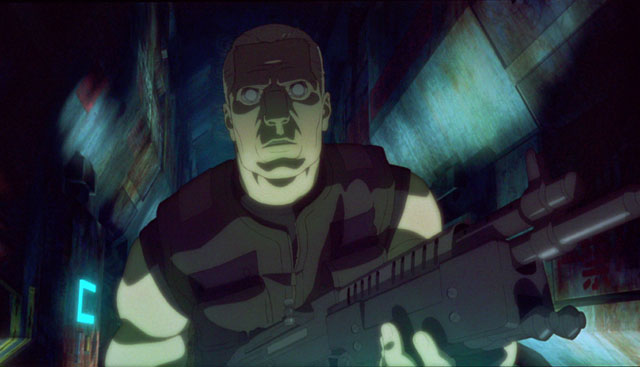
Even if you don’t like the metaphysical mumbo-jumbo or strange pacing, Ghost 2 should be seen as mandatory viewing for its truly mind blowing merging of computer imagery and hand drawn animation artistry. This is cyberpunk at its finest! Truly, Neuromancer’s William Gibson would be floored with the continually awe-inspiring scenery that’s intermixed with the grittiest of settings. I lost count of the number of sets I would have loved to freeze and place on my wall. From the creation of robots complete with fiber optic circuitry and positronic brains, to the dingy alleys of the underworld, the vast expanses of the futuristic building-scapes, this movie employs every color palette in the most effective manner imaginable. Often, you almost stop paying attention to the subtitles to just take in the scene in all its heavenly glory.
On top of this, we get trademark moments of Oshii pacing. Oshii is fully content to leave the dialogue aside for a while and let the mood develop from the visuals and sound. Very few movies do this effectively - Avalon and GITS:2 certainly come to the top of the list. In short, the pacing makes GITS:2 a fully immersive experience in a way that visuals alone couldn’t do.
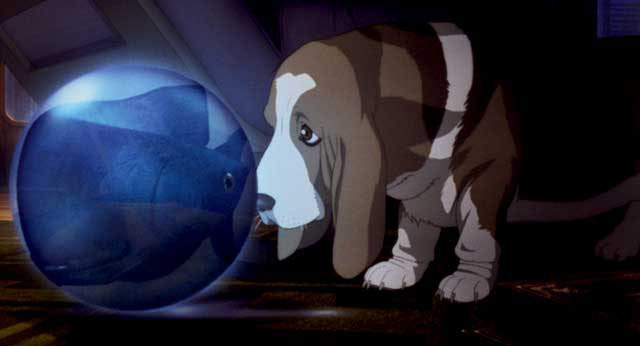
GITS 2 Philosophy: In looking at the philosophy, the first Ghost was dominated by a discussion of what it means to be human and being alive. It culminated in the creation of a new species - the merging of a sentient program called the puppet master with Motoko, an alive human complete with a soul (ghost). Without knowing the details of Ghost 2, one would have expected in seeing the first movie that Oshii would have explored this vast new experience in Ghost 2, Yet this was not to be, as instead the story takes a very different perspective to the ideas covered in the first movie. Innocence is really tracing the idea that what we "see" isn’t at all real, and that reality as a concept needs significant revision. This is done in a variety of ways through mirror analogies, VR segments and discussions of whether there is a difference between artificial life and real life. In this sense, GITS2 is far more the philosophical sequel to Avalon.
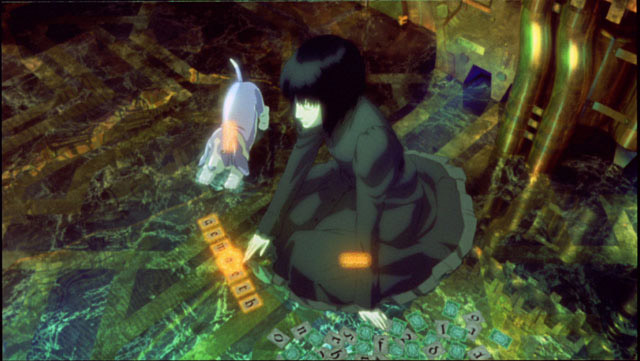
Ghost 2 almost turns the perspective from Ghost one on its head and looks at what it means to be a sentient program and how even humans seeking to become fully cyborg struggle to attain this plateau of ever increasing sensory perception and understanding. Taking Decarte’s notion ("I think, therefore, I am") that sentient life does not require a ghost, Ghost 2 explores the notion that a sentient program or robot (called a "doll") might NOT want to have a ghost, and looks at what happens when ghosts are foisted on dolls. Ideas taken for granted in the real world, like the demarcation between life and death get blended and rendered almost meaningless.
On Dolls: Let’s go into a discussion of dolls for a moment: On one hand, dolls in our terms are purely fake, but in the eyes of a child, are actually "real" in the sense that they are assigned virtual persona and as an object and affect the behavior of the child. In effect, the notion of the child’s mind being constrained to her head is challenged - the child’s mind functions "virtually" in the doll. This notion of a doll is also examined in the sense that it contains our greatest fears - that all we are is a "shell" without something actually unique inside that makes us special. In making a cyborg "doll" that mimics a human - GITS2 poses that we are creating a human-looking shell that is sentient in the Descartes sense, but is not complete. Even worse, when given a facsimile of a ghost, we are doing real harm to the doll as the doll is now neither a stable sentient robot nor a human, but a bastardized thing in-between.
In total, there is this ongoing discussion of three types of "ultimate" life forms: God, Dolls, and animals. They all embody the notion of innocence. God (in this sense, almost synonymous with Major Motoko’s new form) is all knowing so basic human frailties no longer affect her. Needs and desires that humans have are non-existent for God. Dolls, and in cyborg version of dolls - sentient robots, are also perfect in that they can think but don’t fall prey to human inadequacies. Finally, Oshii argues animals such as dogs are innocent. Their joys in life are simple ones - Batou’s dog scenes also serve to demonstrate that which is still "human" about Batou - everything else in his life has been rendered meaningless. In this sense, interestingly the dog takes on the same roll as a doll does with a child - This shows Batou’s mind expressing its "virtual" humanity externally.
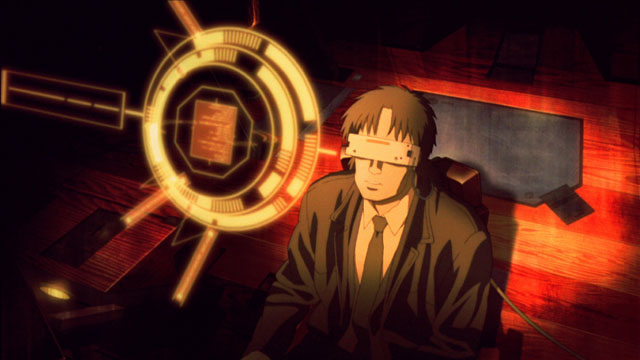
Throughout the movie are instances of humanity’s self-gratification, extreme self-importance and the consequences of over-indulgence. From the enormous cathedrals to the dingy alleyways, to the making of dolls in our own “perfect” shell of ourselves, Oshii’s message is that we are doing everything possible to hide ourselves from true humanity. The beautiful imagery of GITS 2 is the result. Freedom comes not through materialism, but through real “humanity.” However, one wonders whether Oshii thinks real humanity is in anyway restricted to humans. At some level Oshii is saying our bodies are now obsolete, and that what makes us human, our shell, may not be the purview of humans.
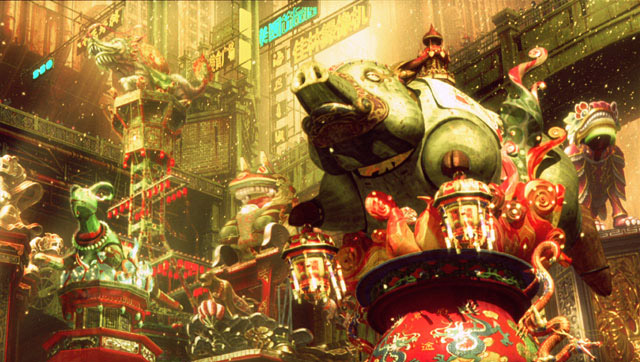
As for the details of the merging of traditional hand drawn animation, there are a few scenes where the Babylon 5-like ships or statues don’t quite fit, but for the most part, the expansive scenes have incredible depth, and the close-ups are as exquisite as a portrait. You are truly missing out on a feat of artistic beauty if pass this movie up. And overall, GITS:2 is clearly in of the best new cyberpunk movies out. Watch it - you won’t be disappointed.
~See movies similar to this one~
Tags: cyberpunk movie review
|




















































